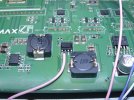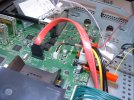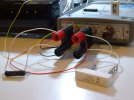In a related thread, I suggested, not entirely seriously
Then
Finally, OP of the original thread said that the resurrection instructions were followed, which would have included re-flashing the box: was that actually done? If some unexpected system management software action (ie, turning off U22) is implicated, could there be a firmware glitch?
You can see what happens at startup in a kernel debug log posted in another thread (look for "brcm-pm", and also be aware that the log is from a faulty system where a kernel bug caused the disk not to spin up). This leads to another thought, that it could be useful to run up a problem system with a debug kernel to see if (a) the U22 turn-off still occurs (b) if so, what is logged for that action.
Other hack solutions: bypass the on-board supply and fit a 5V+12V brick with a SATA adapter, wiring its mains cable to the input of the power supply (CN1), or just a scrap 5V/1A brick wired in place of the LDO regulator (U52) o/p (SG Pipeline 2TB: 5V/0.55A, 12V/0.37A), as the 12V supply is not apparently implicated.Some sort of small timer+relay circuit (as small as a circuit with 2 2-pole or 1 4-pole relay can be) could be interposed in the disk power cable to automate [the process of detaching and re-attaching the disk power around boot]. Actually you can get a 4-pole timer-on relay as a single unit, but at RS it's at least as expensive as a second-hand HDR-Fox T2, though if this listing on "an internet auction site" is to be believed that's 10x too much.
Then
If so, this looks good in principle but ... If my sums are right the capacitor between pin 1 and ground has to be about 960μF per second of delay to reach 2V (of the steady state 2.9V) at pin 1 (assuming the current into pin 1 stays roughly as specified for 0A output). This could have to be some whacking capacitor, relative to the existing one which from the trace above (appearing vertical with 40ms timebase) must be less than 1μF, and even 5x the output capacitor for 0.5s delay. I suppose one could put 470μF, then 47, then 4.7, etc, across pin 1 and ground in parallel with the existing one to test.I think there is a much easier solution, it seems to me that this is an inrush current problem, I.e. the hard disk is creating too big a current demand on start-up, (or the PSU can't cope as well as it used to), the U52 component can be made to limit this inrush current by adding a bigger value capacitor to the control pin (pin 1), see marked capacitor here :-
View attachment 5579
Finally, OP of the original thread said that the resurrection instructions were followed, which would have included re-flashing the box: was that actually done? If some unexpected system management software action (ie, turning off U22) is implicated, could there be a firmware glitch?
The VFD message is set by the...The supply to the HDD is unswitched on the 12V rail but switched on 5V, and the 5V supply turns on when the HDR-FOX comes out of the initial boot phase (indicated by the VFD "Cust FW #.##" turning off).
...
/etc/init.d/S25banner startup script and reset by the settop program, which initiates discovery of the disk, in turn launched by /etc/init.d/S90settop. The documentation on the web for the 7405 power management function is based on a later Linux version (with /sys/power) but I think its statement that SATA is managed by Linux is still valid (some other hardware functions have Nexus APIs).You can see what happens at startup in a kernel debug log posted in another thread (look for "brcm-pm", and also be aware that the log is from a faulty system where a kernel bug caused the disk not to spin up). This leads to another thought, that it could be useful to run up a problem system with a debug kernel to see if (a) the U22 turn-off still occurs (b) if so, what is logged for that action.
Last edited:



















